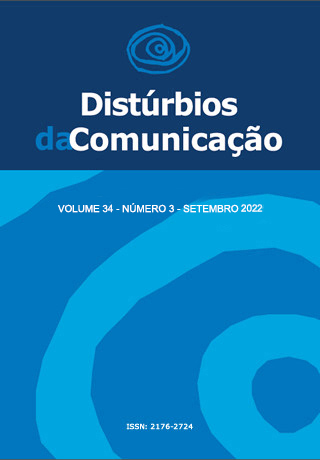Eating and Drinking Ability Classification System – EDACS
equivalência cultural para o português brasileiro
DOI:
https://doi.org/10.23925/2176-2724.2022v34i3e56470Palavras-chave:
Transtornos da deglutição, Alimentação, Paralisia cerebral, Avaliação, Escala, CriançaResumo
Objetivo: realizar a tradução e equivalência cultural e linguística para o Português Brasileiro do Eating and Drinking Ability Classification System (EDACS). Método: realizou-se a tradução do EDACS para a língua portuguesa por duas fonoaudiólogas bilíngues e especialistas em disfagia. As duas traduções foram comparadas entre as próprias fonoaudiólogas, sendo as incompatibilidades discutidas entre si e decisões tomadas por consenso. Após o instrumento traduzido, este foi enviado para uma terceira fonoaudióloga, brasileira, bilíngue, residente nos Estados Unidos, para que a retrotradução para o inglês fosse realizada. A versão inicial do instrumento e a retro tradução foram confrontadas entre si, sendo as discrepâncias analisadas, discutidas e definidas por consenso. Resultados: os processos de tradução e adaptação cultural requereram maior esforço na definição da nomenclatura das consistências utilizadas e não trouxeram modificações com relação à estrutura da escala original. Conclusão: realizou-se a equivalência cultural do Sistema de Classificação das Habilidades do Comer e Beber – EDACS-PT/BR para o português brasileiro.
Downloads
Referências
Calis EA, Veugelers R, Sheppard JJ, Tibboel D, Evenhuis HM, Penning C. Dysphagia in children with severe generalized cerebral palsy and intellectual disability. Dev Med Child Neurol. 2008; 50(8): 625-30.
Arvedson JC. Feeding children with cerebral palsy and swallowing difficulty. Eur J Clin Nutr. 2013; 67: S9-S12
Benfer KA, Weir KA, Bell KL, Ware RS, Davies PSW, Boyd RN. Validity and reproducibility of measures of oropharyngeal dysphagia in preschool children with cerebral palsy. Dev Med Child Neurol. 2015; 57: 358-365.
Benfer KA, Weir KA, Bell KL, Ware RS, Davies PSW, Boyd RN. Oropharyngeal dysphagia and gross motor skills in children with cerebral palsy. Pediatrics. 2013; 131(5): e1553-e1562.
Kim JS, Han ZA, Song DH, Oh HM, Chung ME. Characteristics of dysphagia in children with cerebral palsy, related to gross motor function. Am J Phys Med Rehabil. 2013; 92(10): 912-919.
Morton R, Wheatley R, Minford J. Respiratory tract infections due to direct and reflux aspiration in children with severe neurodisability. Dev Med Child Neurol. 1999; 41: 329-34.
Silvério CC, Henrique CS. Indicadores da evolução do paciente com paralisia cerebral e disfagia orofaríngea após intervenção terapêutica. Rev Soc Bras Fonoaudiol. 2009; 14(3): 381-386.
Lefton-Greif MA, Okelo SO, Wright JM, Colaco JM, McGrath-Morrow SA, Eakin MN. Impact of children´s feeding/swallowing problems: validation of a new caregiver instrument. Dysphagia. 2014; 29: 671-677.
Benfer KA, Weir KA, Bell KL, Ware RS, Davies PSW, Boyd RN. Oropharyngeal dysphagia in preschool children with cerebral palsy: oral phase impairments. Res Dev Disabil. 2014; 35: 3469-3481.
Mishra A, Sheppard JJ, Kantarcigil C, Gordon AM, Malandraki GA. Novel mealtime duration measures: reliability and preliminary associations with clinical feeding and swallowing performance in self-feeding children with cerebral palsy. Am J Speech Lang Pathol. 2018; 27: 99-107.
Crary MA, Carnaby GD, Groher ME. Initial psychometric assessment of a functional oral intake scale for dysphagia in stroke patients. Arch Phys Med Rehabil 2005; 86: 1516-1520.
Sellers D, Mandy A, Pennington L, Hankins M, Morris C. Development and reliability of a system to classify the eating and drinking ability of people with cerebral palsy. Dev Med Child Neurol. 2014b; 56(3): 245-51.
Kitai Y, Hirai S. Okuyama N, Hirotsune M, Nishimoto S, Hirano S, et al. Functional outcomes of children with dyskinetic cerebral palsy depend on etiology and gestational age. Eur J Paediatr Neurol 2021; 30: 108-112.
Ron AG, Toboso RMG, Gascón MB, Santos MT, Vecino R, Pinedo AB. Nutritional status and prevalence of dysphagia in cerebral palsy: usefulness of the eating and drinking ability classification system scale and correlation with the degree of motor impairment according to the gross motor function classification system. Neurologia (Engl Ed) 2020; S0213-4853(20)30044-X.
Bell KL, Benfer KA, Ware RS, Patrao TA, Garvey JJ, Arvedson JC, et al. Development and validation of a screening tool for feeding/swallowing difficulties and undernutrition in children with cerebral palsy. Dev Med Child Neurol 2019; 61: 1175-1181.
Rosenbaum P, Paneth N, Leviton A, Goldstein M, Bax M, Damiano D, et al. A report: the definition and classification of cerebral palsy. Dev Med Child Neurol. 2007; 109: 8-14.
Scientific Advisory Committee of Medical Outcomes Trust. Assessing health status and quality of life instruments: attributes and review criteria. Qual Life Res. 2002;11(3): 193-205.
Pernambuco L, Espelt A, Magalhães Júnior, HV, Lima, KC. Recomendações para elaboração, tradução, adaptação transcultural e processo de validação de testes em Fonoaudiologia. CoDAS 2017; 29(3): e20160217 doi:10.1590/2317-1782/20172016217.
Hyun SE, Yi YG, Shin H. Reability and Validity of the Eating and Drinking Ability Classification System in adults with cerebral palsy. Dysphagia 2021; 36: 351-361.
Viñals-Labañino CP, Velazquez-Bustamante AE, Vargas-Santiago SI, Arenas-Sordo ML. Useful of cerebral palsy curves in Mexican patients: a cross-sectional study. J Child Neurol 2019; 34: 332-338.
Goh YR, Choi JY, Kim SA, Park J, Park ES. Comparations of severity classification systems for oropharyngeal dysfunctions in children with cerebral palsy: relations with other functional profiles. Res Dev Disabil 2018; 72: 248-256.
Downloads
Publicado
Edição
Seção
Licença
Copyright (c) 2022 Carolina Castelli Silvério, Diane Sellers, Daniella Curcio, Maria Inês Rebelo Gonçalves

Este trabalho está licenciado sob uma licença Creative Commons Attribution 4.0 International License.









